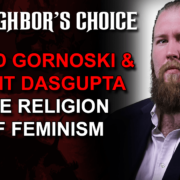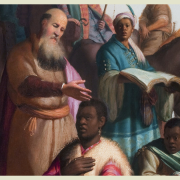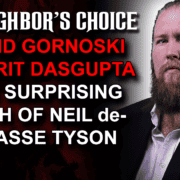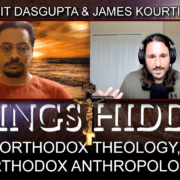A Reflection on the Storytelling Crisis
The recent Star Wars trilogy, known as the sequels, roped in an estimated two billion in box offices worldwide. It is the highest-grossing trilogy of the franchise; immensely profitable, yet there is a crisis that is revealed at the center of it—a crisis that, unsurprisingly, runs deep in most artistic products of contemporary secular culture.
The new Star Wars movies, as compared to the original ones, contain more similarities to your average Christian pop art than, say, early twentieth-century pulp novels of the Edgar Rice Burroughs variety. Star Wars differs consistently from something like the John Carter series (often described as the first or one of the first “space operas”) not only in its worldview but also in its assertiveness and method to push forward an ideology in terms of character, plot, and morals.
Take the “casino” planet scene from The Last Jedi, for example. That scene has all the trappings of a low-budget modern Christian movie. We have stereotypical “capitalists” who are consumed in their greed. We have exploiters and destroyers of the planet’s environment. We have the heroes who collectively act as liberation theology’s version of the revolutionary Jesus whipping away at the money changers in the temple. We have the protagonist who is a flawless embodiment of feminist/matriarchal thinking. And, the icing on the hodgepodge, a vegan gospel, if you will, with Chewbacca pricked to his heart when he is about to devour a penguin-like creature; the look on the Porgs’ faces in that scene is quintessential Bambi-level Disney.
The escapades of Tarzan and John Carter, on the other hand, in comparison to the Disney products, contain very little morals apart from the classic chivalrous aspects of Western storytelling, although “critical theory” academics find much of early twentieth-century racial and colonial tropes in those stories. But yet it cannot be denied that the aggressiveness in presenting a righteous morality is far greater in the Star Wars movies than anything from early twentieth-century America.
The main character of the recent sequels trilogy, for example, exhibit barely any flaws. Rey single-handedly eliminates squads of stormtroopers, fixes the Millenium Falcon without any guidance, doesn’t need a man to hold her hand, rescues herself, overcomes a highly-trained antagonist, destroys the Death Star, and assumes the last name of the diminished messiah. Indeed, many critics were startled at the lack of struggle within her character and labeled her a “Mary Sue.”
Why this heavy-handedness in modern storytelling? Why this increasing and domineering need to check diversity and equity boxes when creating something even so commercialized as Star Wars?
René Girard wrote that there are two types of models human beings try to emulate, and this extends to human artistic creativity as we will observe. External mediators: those who stand as models from far away, whether in time or space and as a result are less susceptible to rivalry. Internal mediators: those who are immediate to the imitator and are prone to conflict. It stands within reason of Girard’s thought that the Star Wars franchise borrows plenty from Joseph Campbell’s The Hero with a Thousand Faces. But it can also be argued, and with greater effect, that the Star Wars stories, especially the most recent ones, in both positive and negative senses, are very imitative of the Gospel story.
How are Disney’s latest space opera products imitative of the Gospel? one might ask. The answer lies not so much in worldview as much as it lies in technique. We have already made note of Chewbacca’s “Saul of Damascus moment” albeit with a vegan twist. The Porg glance strikes Chewbacca’s conscience in a rather caricaturing manner that is characteristic of the animal rights argument: animals are innocent and have feelings too. If Chewbacca’s dilemma is not so convincing then we can also look at the obvious messianic references, the desert planet origins, the satanic antagonist, the frequent themes of self-sacrifice, the influence from the life of King David, and so on.1
If the Star Wars movies are imitative of the Gospel then in what sense are they doing so? This is a far more interesting and relevant question than we may realize. In an earlier article, I have expanded on the inviting character of the Gospel story. Mimesis, like magnetism, is attraction and repulsion. The energy of the Gospel stories is undeniably attractive as evidenced by countless references to it in popular culture, mostly in the positive from the perception of these references. Keeping this in mind, it is obvious that Star Wars imitates the Gospel in both positive and negative senses. Not only that, but the Gospel serves as both external and internal mediator for the Star Wars mythos.
Star Wars is a mythical reaction to the realistic and gritty Gospel account. In the true spirit of the counterculture, Star Wars maintains the social justice aesthetic of the Bible while rejecting its differentiation. The chosen one is a single male hero in the original trilogy, but in the sequels, anyone of any obscure background can become the messiah. Why must a male character from a royal lineage become the chosen one? Isn’t this an outdated patriarchal notion that should be soundly rejected by a progressive and enlightened culture? The writers of the sequels take these questions to heart and, as a result, they struggle to derive from and fight against the original Gospel aesthetic.
Due to the constant clash of Christian and post-Christian worldviews, we get narratives that look very artificial–forcefully assembled. This aggressive and unnatural method of storytelling is present even before the creative process begins. One might have heard the oft-repeated complaint that Hollywood has nothing new to offer and instead settles for remakes or reboots. While it may certainly be the case that this is the result of a creatively bankrupt industry, one shouldn’t overlook the conscious decision of the producers to replace the old with the new.
The replacement factor is present even within the stories. We have already observed how Rey becomes the new chosen one while Luke Skywalker is relegated to the background and exiled off to a remote island where he is content at sucking milk from the udder of an embarrassed alien creature. The effect that this replacement scheme creates is rather jarring, to say the least.
This entire conflict and contradiction in the narrative arise from the fact that the writers cannot comprehend the nature of the Gospel story. The Gospel accounts, within the framework of the Bible, connects both the past and the future through types and symbols. The Gospel, in the person of Jesus Christ, provides a magnetic hero that connects man and God and then strikes a ripple effect in the ocean of time and changes history. Jesus does not abolish the law, as He declares, but instead fulfills it. Christ, contrary to the spirit of revolution that has gripped modern man, expands on the narrative in the Old Testament and brings out the reality from behind the veils and symbols of the Old Testament.
Moses and Elijah are not exiled like Luke Skywalker; they are united with the Son of God. Christ does not brush aside the trials and sufferings of the prophets, but instead He magnifies it and successfully overcomes it. In order words, Christ is the ultimate archetype against the Gary Stus and Mary Sues of human storytelling. In Christ’s story, the much-dreaded outsiders and even the willing “enemies” are redeemed. In modern storytelling, some of these key factors are unconsciously retained by the writers, but they are in sharp conflict with messages of counter-culture which state that anti-progressive elements must be extinguished at all costs.
The storytelling crisis, in summary, has very much to do with the religious schizophrenia that has engulfed western culture at large. On one hand, we are being told that institutionalized religion and even spirituality are akin to superstitious nonsense, and on the other hand, we are told that the anthropological message of religion, Christianity in particular, is beneficial and must be retained. The greater question, however, is: how much of the Gospel should be discarded or retained in order to produce a perfect secular narrative that, unlike the existing narratives, reconciles the past with the future while redeeming our enemies? Perhaps the answer lies in the person of Christ. Perhaps His character deserves a much more attention than we are often willing to give.
- For a more detailed analysis, click here for Conrad Flynn’s take.












Leave a Reply
Want to join the discussion?Feel free to contribute!